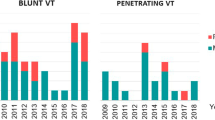Abstract
Purpose
The purpose of this study was to assess the incidence, treatment and outcome of vascular trauma in a well-defined geographical region in Finland.
Methods
A retrospective analysis was conducted of patients admitted to Tampere University Hospital (TAUH), Pirkanmaa, Finland, due to vascular trauma between January 2006 and December 2010. Data regarding trauma mechanism, anatomical location, treatment, and short-term outcome were collected from patients’ files and vascular register.
Results
Altogether, 143 non-iatrogenic vascular traumas occurred during the study period resulting in an annual trauma incidence of 5.8/100,000/year in the TAUH region. The majority of the injuries were located in the upper extremities (N = 83, 58 %). Penetrating injuries comprised 58 % (83 patients) of all vascular trauma admissions and were significantly more common among men compared to women (83 and 17 %, respectively). The majority (N = 93, 65 %) of the injuries were treated surgically, while in 15 (11 %) patients the trauma was resolved by endovascular means. The remaining 35 (24 %) patients were successfully managed conservatively, i.e., by observation or wound exploration only without the need for later (30-day) vascular repair. Two out of 17 patients (12 %) with lower extremity vascular trauma required major amputation. Procedure-related complications occurred in five patients. In-hospital and 30-day mortality was zero.
Conclusions
This paper demonstrates that the incidence of non-iatrogenic civilian vascular trauma in the Pirkanmaa region is low and mainly caused by penetrating injury. Further, the majority of vascular traumas are still treated surgically. In general, the short-term survival of patients who survive the initial trauma is good.
Similar content being viewed by others
References
Kauvar DS, Sarfati MR, Kraiss LW. National trauma databank analysis of mortality and limb loss in isolated lower extremity vascular trauma. J Vasc Surg. 2011;53:1598–603.
Jaha L, Andreevska T, Rudari H, et al. A decade of civilian vascular trauma in Kosovo. World J Emerg Surg. 2012;20:7–24.
Perkins ZB, De’Ath HD, Aylwin C, et al. Epidemiology and outcome of vascular trauma at a British Major Trauma Centre. Eur J Vasc Endovasc Surg. 2012;44:203–9.
Mosquera VX, Marini M, Cao I, et al. Traumatic aortic injuries associated with major visceral vascular injuries in major blunt trauma patients. World J Surg. 2012;36:1571–80.
Tan TW, Joglar FL, Hamburg NM, et al. Limb outcome and mortality in lower and upper extremity arterial injury: a comparison using the National Trauma Data Bank. Vasc Endovasc Surg. 2011;45:592–7.
Franz R, Goodwin R, Hartman J, et al. Management of upper extremity arterial injuries at an urban Level I Trauma Center. Ann of Vasc Surg. 2009;23:8–16.
Fingerhut A, Leppaniemi AK, Androulakis GA, et al. The European experience with vascular injuries. Surg Clin North Am. 2002;82:175–88.
Bilgen S, Turkmen N, Eren B, et al. Peripheral vascular injury-related deaths. Turk J Trauma Emerg Surg. 2009;15:357–61.
Padayachy V, Robbs JV, Mulaudzi TV, et al. A retrospective review of brachial artery injuries and repairs—is it still a “training artery”? Injury. 2010;41:960–3.
Hussain ST, Aslam S, Khan RA, et al. An observational study of 256 cases of vascular trauma in the North Western Province of Pakistan. Ann R Coll Surg Engl. 2001;83:388–91.
Thomas MO, Giwa SO, Adekoya-Cole TO. Arterial injuries in civilian practice in Lagos, Nigeria. Niger J Clin Pract. 2005;8:65–8.
Wani ML, Ahangar AG, Wani SN, et al. Peripheral vascular injuries due to blunt trauma (road traffic accident): management and outcome. Int J Surg. 2012;10:560–2.
Moláček J, Třeška V, Houdek K, et al. Vascular system injuries. Acta Chir Orthop Traumatol Cech. 2012;79:451–4.
Ekim H, Tuncer M. Management of traumatic brachial artery injuries: a report on 49 patients. Ann Saudi Med. 2009;29:105–9.
Rasouli MR, Moini M, Khaji A. Civilian traumatic vascular injuries of upper extremity: report of the Iranian National trauma project. Ann Thorac Cardiovasc Surg. 2009;15:389–93.
Wali MA. Upper limb vascular trauma in the Asir region of Saudi Arabia. Ann Thorac Cardiovasc Surg. 2002;8:298–301.
Siau RT, Moore A, Ahmed T, et al. Management of penetrating neck injuries at a London trauma centre. Eur Arch Otorhinolaryngol. 2012;7:2123–8.
Kalish J. Selective use of endovascular techniques in the management of vascular trauma. Semin Vasc Surg. 2010;23:243–8.
Johnson CA. Endovascular management of peripheral vascular trauma. Semin Intervent Radiol. 2010;27:38–43.
Small Arms Survey. (2007). The Small Arms Survey 2007: Guns and the City. Retrieved from http://www.smallarmssurvey.org/publications/by-type/yearbook/small-arms-survey-2007.html.
Conflict of interest
Rikumatti Pöyhönen, Velipekka Suominen, Ilkka Uurto and Juha Salenius declare that they have no conflict of interest.
Ethical standard
Owing to the registry-based nature of the study, an approval by an ethical committee was not applicable.
Author information
Authors and Affiliations
Corresponding author
Rights and permissions
About this article
Cite this article
Pöyhönen, R., Suominen, V., Uurto, I. et al. Non-iatrogenic civilian vascular trauma in a well-defined geographical region in Finland. Eur J Trauma Emerg Surg 41, 545–549 (2015). https://doi.org/10.1007/s00068-014-0460-1
Received:
Accepted:
Published:
Issue Date:
DOI: https://doi.org/10.1007/s00068-014-0460-1




